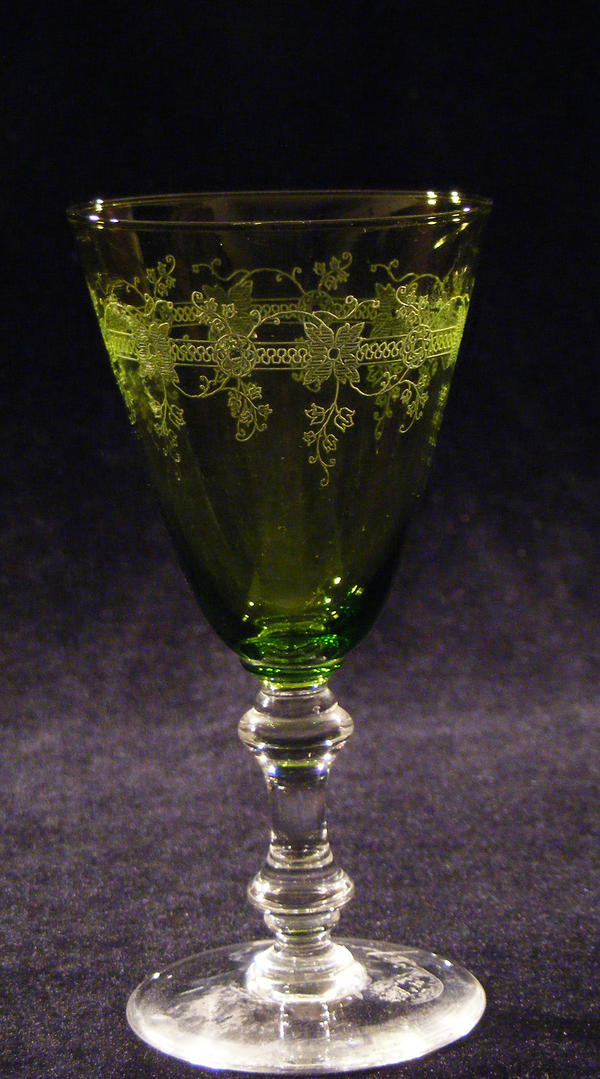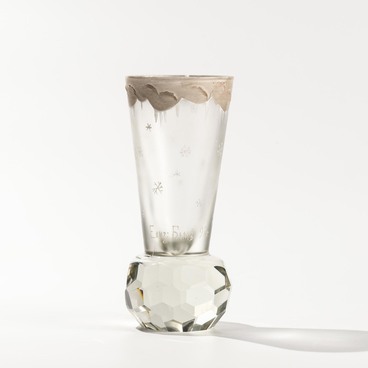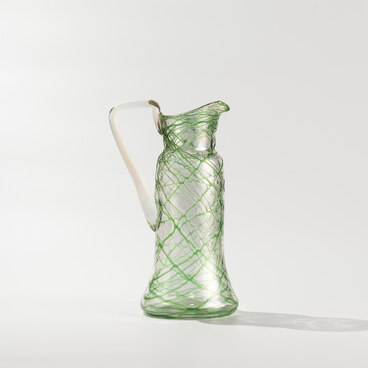The shot glass displayed in the museum is a vivid example of the Art Nouveau style that was incredibly popular in Russia at the turn of the 20th century. This was the artistic genre that helped to bring together advanced technologies and natural beauty, mass production and high aesthetic ideals. This style was characterized by using the shapes of natural objects, plants, and animals, as interpreted by the artist. The craftsmen of the Dyatkovo Factory managed to enrich their works with the most distinctive features of this style: the ductile and flowing nature of molten glass and the use of natural motifs such as flowers, fruits, and interwoven stalks.
The leg of the shot glass is made of colorless glass and the upper part is made of green glass. This shade was achieved by adding chromium compounds to the glass mass. The upper part of the glass is decorated with garlands of fantastic, fanciful flowers achieved using the guilloché method. This chemical etching technique was invented in the second half of the 18th century. It consists in covering the glass surface with a special protective mastic and then scratching out the image while revealing the glass. The mastic is made based on bee wax, mineral wax, paraffin, ceresin, resins, and colophony. The protective coatings are made using such solvents as turpentine or benzol. After the corresponding parts of the protective coating have been removed, the product is treated with hydrofluoric acid which etches the image in the areas not protected by the mastic. After that, the remaining mastic is removed from the glass, and a thin and delicate frosted image is obtained.
The Dyatkovo Crystal Factory made extensive use of guilloché etching in decorating their drinking products. To do that, the factory installed Belgian guilloché machines which allowed engraving mass-produced items in a fast and precise manner. They were used for copying and transferring scaled-up and scaled-down images onto assorted glassware. This decoration technique was gradually substituted by simpler and more efficient methods and has been almost completely forgotten by now.
The leg of the shot glass is made of colorless glass and the upper part is made of green glass. This shade was achieved by adding chromium compounds to the glass mass. The upper part of the glass is decorated with garlands of fantastic, fanciful flowers achieved using the guilloché method. This chemical etching technique was invented in the second half of the 18th century. It consists in covering the glass surface with a special protective mastic and then scratching out the image while revealing the glass. The mastic is made based on bee wax, mineral wax, paraffin, ceresin, resins, and colophony. The protective coatings are made using such solvents as turpentine or benzol. After the corresponding parts of the protective coating have been removed, the product is treated with hydrofluoric acid which etches the image in the areas not protected by the mastic. After that, the remaining mastic is removed from the glass, and a thin and delicate frosted image is obtained.
The Dyatkovo Crystal Factory made extensive use of guilloché etching in decorating their drinking products. To do that, the factory installed Belgian guilloché machines which allowed engraving mass-produced items in a fast and precise manner. They were used for copying and transferring scaled-up and scaled-down images onto assorted glassware. This decoration technique was gradually substituted by simpler and more efficient methods and has been almost completely forgotten by now.



